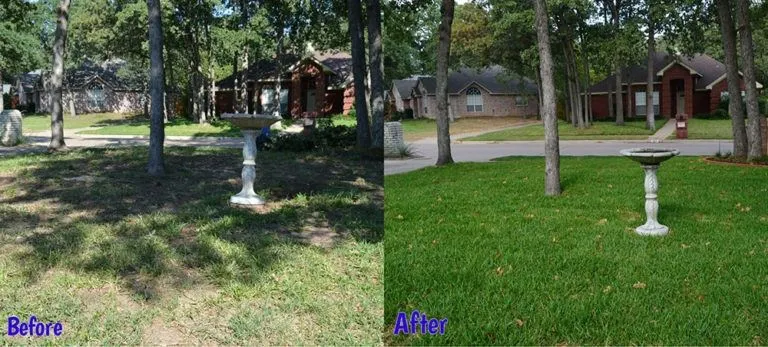At the height of summer, grass around North Texas typically flourishes. The increase in warmth, long hours of bright sunlight, and excessive energy all make grass capable of growing rapidly—to the point where you might find yourself cutting it multiple times each week! However, if your lawn seems weak, thin, or unhealthy, you might be wondering what you can do to salvage it and help it return to its peak condition once again. After all, a strong lawn looks beautiful while a failing lawn can be an eyesore.
If you find that your lawn is struggling, then this blog may have the solution for you. Here are four tips to help you rescue your struggling lawn and restore it to peak of its health once again.
Increase Watering
Does your lawn seem thin, weak, or dull in color? It might not be diseased or sickly, it just might be thirsty. During summer, long hours of sunlight and extreme heat can evaporate a lot of water away from your lawn, resulting in grass that is weak, brittle, and appears as though it might be on the verge of dying. If you aren’t watering your lawn enough, this problem will only get worse. During the height of summer, you may have to increase your watering, both in frequency and in time.
If you have an irrigation system, you might want to consider setting it to water additional days each week to make sure your lawn doesn’t go thirsty. You might also want to consider increasing the amount of time your irrigation runs for in order to make sure your lawn’s soil gets a nice, thorough soaking. Finally, if you haven’t already, shift your watering period to sometime either at night or in the very early morning—before the sun comes up. Watering during the heat of the day will cause a lot of water loss to evaporation and could burn your lawn due to amplified glare from water droplets hitting your lawn.
Apply a Lawn Booster
Lawn boosters come in a variety of different types, forms, and functions. Some boosters are designed to provide strength and color in the form of fertilization and food that is good for your lawn’s health. Some boosters tackle challenges your lawn might be dealing with, such as disease that causes dead spots. Some boosters are designed to protect your lawn and target weeds that might pull moisture and nutrients away from it like clovers and dandelions. Whatever issues your lawn is dealing with, do some research and you can probably find a product that helps with it.
However, not all lawn boosters are created equal, and not all lawn boosters have the same requirements. Some lawn boosters can be applied with one simple treatment, while others might require additional treatments or care beyond a single treatment in order to really keep the problem away. Almost no lawn booster should be applied immediately after mowing your lawn—your lawn generally needs a couple of days to heal after mowing, and this is when any applications will be at their most effective. Make sure to read the instructions on the package of any product you purchase, and always do your research on any products before applying.
Leave the Clippings Behind
When you mow your lawn, you’re actually robbing it of resources and nutrients that it needs and could otherwise use. While grass clippings may seem like a pain when they are constantly blowing around your property (and they leave your home looking like an unsightly mess), gathering them up isn’t always the ideal decision. Foregoing the bag and instead allowing the clippings to lay where they fall allows them to decompose naturally and return the nutrients and fertilizer to the soil. This helps your lawn grow bigger, stronger, and more vibrant.
Aerate Your Lawn
Finally, aerating your lawn is an extremely important chore that you should carry out semi-frequently. As you walk on your lawn and use it for your day-to-day purposes, the pressure you place on your soil will cause the soil to compact around your lawn’s roots. The more compacted the soil becomes, the harder it becomes for roots to seek out resources like nutrients, water, and oxygen. If the soil becomes too compact, your lawn will slowly start to weaken until it ultimately dies.
The solution to this is a process known as aeration. Aerating your lawn is a process that involves pulling small plugs of dirt and soil out of the ground at regular intervals, usually a few inches apart. This process is messy and can be labor intensive if you don’t use a machine that makes the process faster. However, the plugs of dirt that are removed will generally decompose and fall apart after a few days, and your lawn should return to looking like normal within a week or so. And the gaps in your soil (which are eventually filled over time as the soil in your lawn shifts and spreads) allow water, nutrients, and oxygen to penetrate much deeper into the soil. This gives your lawn a more robust root system and allows it to sustain stronger, thicker, and more sustained growth for long periods of time.
Lawns that get a lot of use should do this at least once a year, while general backyard lawns probably won’t need it for every two to three years on average.
Need help keeping your lawn looking great? Talk to the team at Purple Care about your options! Dial (817) 880-6052 today to schedule an appointment.




Comments (0)
Thanks for your comment!
Thanks for your feedback! Your comments have been successfully submitted! Please note, all comments require admin approval prior to display.
Error submitting comment!
There is a problem with your comment, please see below and try again.